Wiliwili and Wall-E
Tuesday, August 5th, 2008Now and then my husband and I actually escape from the mundane weekend world of yard work and the occasional movie and do something interesting. At the end of June we went on a hike on the dry and austere south side of Haleakala. Starting from Piilani Highway, we hiked down a jeep road to the coast, and then for some miles through the lava fields along the “King’s Trail” to La Perouse Bay (Keoneoio). The King’s Trail is an amazing story in itself, built 150 years ago over extremely rough a’a lava flows — but this blog entry is about the groves of wiliwili trees we passed on the way downhill.
This area was once dryland forest, now long gone, with only some remnant native trees left. It’s still amazingly beautiful, but sad as well. Presumably when it was forested the rainfall was higher — studies have shown that forests on high elevation island slopes do seem to affect the net rainfall. At any rate, our hike was at the end of June, in very dry conditions.
Wiliwili trees (Erythrina sandwicensis) are probably the most common of the surviving native species. In dry areas they will spend much of the year in a leafless condition, producing leaves and beautiful flowers only when there has been a good deal of rain.
On this hike, I was very keen to see how the wiliwili trees were holding up. A couple of years ago the islands were invaded by a tiny gall wasp, which rapidly destroyed almost all non-native wiliwili trees that are commonly used for landscaping. The native trees are also attacked, but I’m happy to report that the trees in the area of our hike are still holding on. Their remote location may offer them an advantage, as well as their habit of dropping all their leaves.
Wiliwilis are legumes, and their seed is a good-sized orange bean. I picked up a few from the ground under a tree that clearly served to shade cattle on a hot day — so there was no hope they would have sprouted in their native habitat. One of them sprouted right away, another a couple of weeks later, and the rest have recently taken off after I cracked their seed coats. Here is a picture of the first to grow: 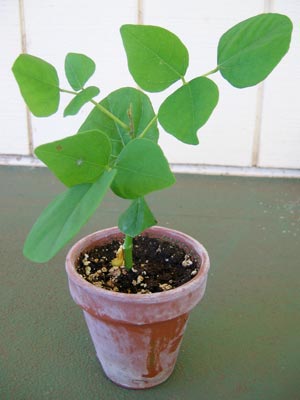
The seedling reminds me a lot of the sprout in the movie Wall-E. Sometimes I feel like I’m the only one who walked out of the theater after that movie feeling rather depressed. Yes, the movie was cute, sweet, and entertaining, but the Earth does not recover from ecological damage like that, at least on a time scale that matters to the human species.
At any rate, I hope the gall wasps don’t figure out that I’m harboring a wiliwili nursery in upper Kula, and I hope that whitish spot on the leaf of the seedling is not the first sign of something bad.
Here are a few photos from the hike:
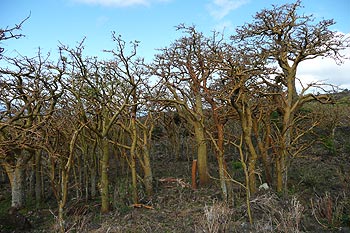
A grove of wiliwili trees, leafless under dry conditions
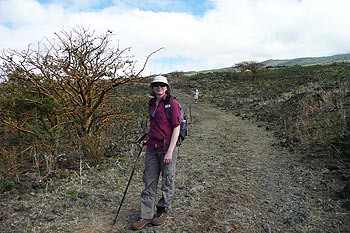
That’s me, hiding from excess sunlight, as always.
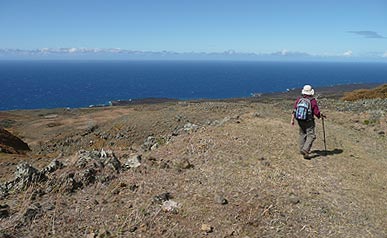
It’s an austere landscape.
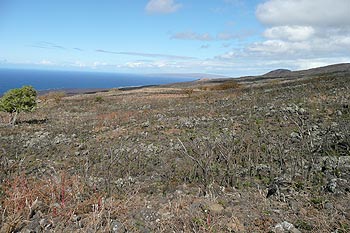
A panoramic of the south slope. The lone green tree is a native, Reynoldsia, I believe. The brown leafless trees in the distance are wiliwili, though they’re hard to see at this image resolution. That’s the island of Kahoolawe in the background.








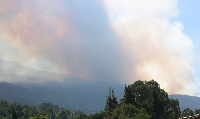 We aren’t used to major forest fires on Maui — after all, there just isn’t that much land, and most of the forests are rain forests — but there are also large areas in the mountains that are dense with imported eucalyptus trees, black wattle, and even redwoods. That’s what’s burning now. The fire started a few days ago, and seems to have gotten quickly out of hand. The photo at right shows only the northern end. 600 acres had been burned as of yesterday; a lot more has burned since then.
We aren’t used to major forest fires on Maui — after all, there just isn’t that much land, and most of the forests are rain forests — but there are also large areas in the mountains that are dense with imported eucalyptus trees, black wattle, and even redwoods. That’s what’s burning now. The fire started a few days ago, and seems to have gotten quickly out of hand. The photo at right shows only the northern end. 600 acres had been burned as of yesterday; a lot more has burned since then.